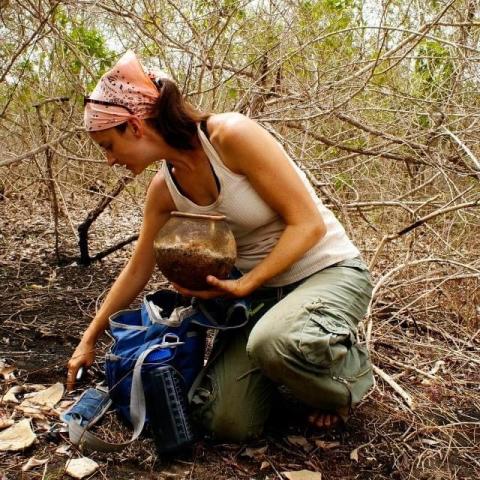Professor of Anthropology

Biography
Dr. Gijanto is an archaeologist examining issues of status, identity and race. Her research spans the 17th to the 20th centuries in West Africa and the Chesapeake. She has completed archaeological projects in The Gambia and Maryland and participated in projects in the US northeast, Jamaica, and Liberia. Her early work was centered on the village of Juffure and the Niumi Commercial Center on the Gambia River examining the rapid rise and decline of the region connected to the beginning of the Atlantic Trade and 19th century British Abolition efforts. This is complimented by her work in southern Maryland examining the formation of colonial and enslaved identities from the 17th to 19th centuries. Her latest project at the Chiles Homesite (Charles County) is focused on identify the post-emancipation community associated with the site.
She has received grants from Fulbright, National Endowment for the Humanities, Harvard University, Brown University and the National Science Foundation.
Areas of Research Specialization
- Slavery and Emancipation
- African Atlantic
- Historical Archaeology
Areas of Teaching Specialization
- Archaeology
- Atlantic World
- Status and Identity
Education
-
B.A. in History and Anthropology at Rutgers University, 2000
-
M.A. in Archaeology at University College of London Institute of Archaeology, 2002
-
Ph.D. in Anthropology at Syracuse University, 2010
Awards
- Kathleen Kirk Gilmore Dissertation Award, 2012
presented to a recent graduate whose dissertation is considered by the Kathleen Kirk Gilmore Dissertation Award Panel to be an outstanding contribution to historical archaeology.
- 2021-2023 Pandion haliaetus Professorship
Spotlight
- Ceramic Production and Dietary Changes at Juffure Gambia (with Sarah Walshaw)
This paper explores the connection between ceramic production and dietary changes immediately before, during, and through the decline of the Atlantic trade at Juffure on the Gambia River. The height of the Atlantic trade in the eighteenth century was a period of increased ceramic production and technical experimentation. Simultaneously, there is increase in the diversity of consumption evident in the faunal and botanical remains recovered. This diversity, in both ceramic manufacture and diet, all but disappears with the decline of the Atlantic trade on the river. It is argued that the greater variety observed in ceramic manufacture during the height of the Atlantic trade is related to social practices of display associated with food. This is accomplished through a comparison of everyday and special events composed of displays of food and wealth across ethnic boundaries. These are indicative of different traditions of consumption and discard rather than signaling ethnic differentiation.
- Historic Preservation and Development in Banjul, The Gambia
The city of Banjul and Gambia colony were established as part of the British abolition efforts on the West African coast in 1816. Unfortunately, the role of Banjul and Gambia in ending the trans-Atlantic slave trade is overshadowed by the current emphasis within the heritage tourism sector on the local dynamics of the slave trade. This, coupled with the continual expansion of port facilities within the capital city of Banjul, has led to the rapid disappearance of much of the nation’s colonial past. This article addresses the challenges and possibilities for cultural resource management as an aid to development and interpretation in Banjul and The Gambia.
- Personal Adornment and Expressions of Status: Beads and the Gambia River’s Atlantic Trade
The presence of glass trade beads at Atlantic trade period sites is often thought to provide limited information for the analyst. Several archaeologists working in West Africa have addressed the difficulty of using beads as chronological markers, let alone using these objects to discern local patterns of demand, preference, or consumption. Overall, few scholars have moved beyond the development of descriptive catalogues to determine what information can be ascertained from bead collections other than chronological data. At Juffure on the Gambia River, bead attributes such as shape, color, and size inform the analyst of how change in the demand for and availability of beads were tied to changing local notions of taste and value.
- The Life of Trade: Events and Happenings in the Niumi's Atlantic CenterThe Life of Trade utilizes archaeological and historical sources to address the dynamic nature of the Atlantic trade on the Gambia River. Taking a fresh multi-disciplinary approach, the book highlights the region’s atypical position as a commercial crossroads and access point for both interior and Atlantic markets. This engagement with a diversified commodities trade brought about the formation of a multi-ethnic, multi-religious community which was supported by, and reliant on, economic exchange. Gijanto situates the Niumi Kingdom within the emerging capitalist world-system through the analysis of data collected from archaeological excavations at four sites: the central multi-ethnic trading village of Juffure, the associated British merchant company factory there, and the two nearby settlements of San Domingo and Lamin Conco.
As part of the Atlantic world, residents were in a continual process of negotiation between their local socio-economic structures and the commodities and ideas introduced by foreign traders. Gijanto sheds light on these interactions, exploring the impact of increased access to wealth by examining a number of excavated objects associated with public display, including European glass trading beads, faunal and botanical remains and locally produced ceramics. Presenting new perspectives on the complex nature of the Atlantic trade in the region The Life of Trade enriches our understanding of this period of great change in West Africa. - Serving Status on the Gambia River Before and After AbolitionThe Atlantic slave trade and its abolition created two distinct commercial spaces on the Gambia River that represent the use of similar tactics to project socioeconomic identities at different points in the Atlantic trade that are compared in this paper. First, the trading village of Juffure, at the heart of the Niumi polity’s commercial center, gained prominence during the height of the trade in the eighteenth century. It became home to a multiethnic community whose residents were entangled to varying degrees in commerce. Community members asserted status and identity through material means that were based in established traditions of crafting and feasting. A second and distinct commercial space emerged at the city of Bathurst, which the British established following abolition in 1807. This new commercial center took shape with its own unique multiethnic community. At Bathurst the “Liberated Africans” utilized Western middle-class practices including meals to assert their identity as African elite. Thus, both the Liberated Africans and residents of Juffure used foodways to project specific identities to gain entry into commerce.
